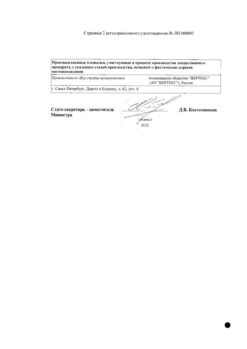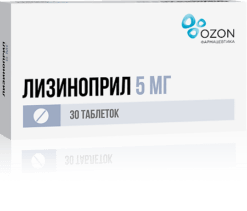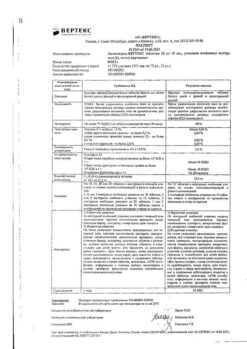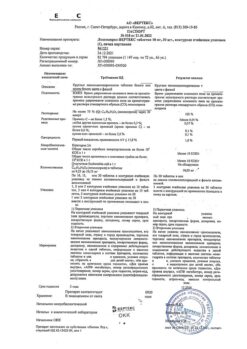No products in the cart.
Lisinopril, tablets 10 mg 30 pcs
€3.38 €2.81
Out of stock
(E-mail when Stock is available)
Description
An angiotensin-converting enzyme (ACE) inhibitor, reduces the formation of angiotensin II from angiotensin I. Decreased angiotensin II leads to a direct decrease in aldosterone release. Reduces bradykinin degradation and increases prostaglandin synthesis.
Limits total peripheral vascular resistance (TPR), blood pressure (BP), preload, pulmonary capillary pressure, causes an increase in the minute blood volume and increases myocardial tolerance to load in patients with chronic heart failure. Dilates arteries more than veins. Some effects are explained by the effect on renin-angiotensin-aldosterone system (RAAS).
Long-term use reduces myocardial hypertrophy and arterial wall resistance. It improves blood supply of ischemic myocardium.
The ACE inhibitors prolong life expectancy in patients with chronic heart failure (CHF), delay progression of left ventricular dysfunction in patients who have had acute myocardial infarction without clinical manifestations of heart failure. Onset of action of the drug is in 1 hour, the maximum antihypertensive effect is achieved in 6-7 hours and lasts for 24 hours.
The duration of the effect also depends on the size of the dose taken. In arterial hypertension, the effect is noted in the first days after the start of treatment, a stable effect develops after 1-2 months of therapy. No pronounced increase in BP was observed when lisinopril was abruptly withdrawn.
Lisinopril reduces albuminuria. It does not affect blood glucose concentration in diabetic patients and does not lead to increased incidence of hypoglycemia.
Pharmacokinetics
Intake.
Lisinopril is absorbed from the gastrointestinal tract (GIT) by an average of 25% after oral administration, but absorption can vary from 6 to 60%. The bioavailability is 29%. Maximum plasma concentration (Cmax) is reached after 7 h. Food intake does not affect the absorption of lisinopril.
Distribution.
Lisinopril binds slightly to plasma proteins. Permeability through the blood-brain barrier and the placental barrier is low. Metabolism. Lisinopril is not biotransformed in the body.
Elimation.
Lysinopril is excreted unchanged by the kidneys. The elimination half-life (T1/2) is 12.6 hours. Lisinopril clearance is 50 ml/min. The decrease in serum concentration of lisinopril occurs in two phases. The bulk of lisinopril is excreted during the initial alpha phase (effective T1/2- 12 h), followed by the terminal distant beta phase (about 30 h).
Pharmacokinetics in selected patient groups
In patients with CHF the absorption and clearance of lisinopril is reduced and the bioavailability is 16%.
In patients with renal insufficiency (creatinine clearance (CK) less than 30 ml/min), lisinopril concentrations are several times higher than plasma concentrations in healthy volunteers, with increased time to reach Cmax in plasma and increased T1/2.
In elderly patients the plasma concentration of the drug and the area under the curve “concentration-time” are 2 times greater than in younger patients.
In patients with cirrhosis the bioavailability of lisinopril is reduced by 30% and clearance by 50% compared to patients with normal liver function.
In elderly patients the blood concentration of lisinopril is increased on average by 60%.
Indications
Indications
Active ingredient
Active ingredient
Composition
Composition
How to take, the dosage
How to take, the dosage
Ingestion, regardless of meals. In patients with arterial hypertension who are not receiving other hypotensive agents, 5 mg once daily is prescribed. If there is no effect, the dose is increased every 2-3 days by 5 mg to an average therapeutic dose of 20-40 mg/day (an increase in dose over 40 mg/day usually does not lead to further BP reduction). The usual daily maintenance dose is 20 mg. The maximum daily dose is 40 mg.
The full effect usually develops in 2-4 weeks from the start of treatment, which should be taken into account when increasing the dose. In case of insufficient clinical effect it is possible to combine the drug with other hypotensive agents.
If the patient received prior treatment with diuretics, it is necessary to stop taking these drugs 2-3 days before starting Lisinopril. If this is not feasible, the initial dose of Lisinopril should not exceed 5 mg per day. In this case, after the first dose it is recommended that the physician controls for several hours (maximum effect is reached after about 6 hours), as a marked decrease in BP may occur.
In renovascular hypertension or other conditions with increased activity of renin-angiotensin-aldosterone system it is reasonable to administer also low initial dose – 2.5-5 mg per day under increased medical control (BP control, renal function, serum potassium concentration). The maintenance dose, while continuing close medical supervision, should be determined depending on the dynamics of BP.
In renal failure, due to the fact that lisinopril is excreted through the kidneys, the initial dose should be determined according to creatinine clearance, then according to the response, a maintenance dose should be established with frequent monitoring of renal function, serum potassium, sodium levels.
In persistent arterial hypertension, long-term maintenance therapy at 10-15 mg/day is indicated.
In chronic heart failure – start with 2.5 mg once daily, with subsequent dose increases by 2.5 mg after 3-5 days to the usual, maintenance daily dose of 5-20 mg. The dose should not exceed 20 mg per day.
Elderly people often have a more pronounced long-term hypotensive effect due to decreased excretion rate of lisinopril (it is recommended to start treatment with 2.5 mg/day).
Acute myocardial infarction (as part of combined therapy)
In the first day – 5 mg orally, then 5 mg every other day, 10 mg every other day and then 10 mg once daily. In patients with acute myocardial infarction the drug should be used for at least 6 weeks.
At the beginning of treatment or during the first 3 days after acute myocardial infarction in patients with low systolic blood pressure (120 mm Hg or lower) a lower dose – 2.5 mg should be administered. In case of BP decrease (systolic BP below or equal to 100 mmHg), the daily dose of 5 mg may be temporarily reduced to 2.5 mg, if necessary. In case of prolonged marked BP lowering (systolic BP below 90 mmHg for more than 1 hour), the treatment with Lisinopril should be stopped.
Diabetic nephropathy
In patients with insulin-independent diabetes 10 mg of Lisinopril is taken once daily. The dose can be increased up to 20 mg
once a day if necessary in order to achieve diastolic BP values below 75 mmHg in sitting position. The dosage is identical in patients with insulin-dependent diabetes mellitus in order to achieve values of diastolic BP lower than 90 mmHg at sitting position.
Interaction
Interaction
Lisinopril decreases potassium excretion when treated with diuretics.
Special caution is required when using the drug concomitantly with:
Cautiously may be used with:
Alcohol increases the effect of the drug.
Special Instructions
Special Instructions
Symptomatic hypotension
Most often a pronounced decrease in BP occurs with a decrease in fluid volume caused by diuretic therapy, reduction of salt in food, dialysis, diarrhea or vomiting. In patients with chronic heart failure with or without concomitant renal failure, pronounced BP reduction is possible. It is more often found in patients with severe stage of chronic heart failure, as a consequence of high doses of diuretics, hyponatremia or impaired renal function. In such patients the treatment with Lisinopril should be started under strict medical supervision (choose the dosage of the drug and diuretics with caution).
Similar rules should be observed when administering it to patients with coronary heart disease, cerebrovascular insufficiency, in whom a sharp decrease in BP may result in myocardial infarction or stroke.
Transient hypotensive reaction is not a contraindication for the next dose of the drug.
When using Lisinopril in some patients with chronic heart failure but with normal or reduced BP a decrease in BP may be noted, which is usually not a reason to discontinue treatment.
Before starting treatment with Lisinopril, if possible, normalize sodium concentration and/or replenish lost fluid volume, carefully monitor the effect of the initial dose of Lisinopril on the patient.
In case of renal artery stenosis (especially in bilateral stenosis, or in the presence of artery stenosis of the only kidney), as well as in circulatory failure due to lack of sodium and/or fluid, the use of Lisinopril may also lead to impaired renal function, acute renal failure, which usually prove irreversible after drug withdrawal.
In acute myocardial infarction
Standard therapy (thrombolytics, acetylsalicylic acid, beta-adrenoblockers) is indicated. Lisinopril may be used in conjunction with intravenous administration or with therapeutic nitroglycerin transdermal systems.
Surgery/general anesthesia
During major surgical interventions, as well as during the use of other drugs that cause BP reduction, lisinopril, by blocking angiotensin II formation, may cause a pronounced unpredictable BP reduction.
In elderly patients the same dose leads to higher blood concentration of the drug, so special caution is required in determining the dose.
Since the potential risk of agranulocytosis cannot be excluded, periodic blood count monitoring is required. When using the drug in dialysis with a polyacrylonitrile membrane, anaphylactic shock may occur, so it is recommended either to use another type of dialysis membrane or to prescribe other antihypertensive agents.
Effect on driving and operating machinery
There are no data on the effect of lisinopril on driving and operating machinery used in therapeutic doses, but it should be taken into account that dizziness may occur, so caution should be exercised.
Contraindications
Contraindications
Hypersensitivity to lisinopril or other ACE inhibitors, history of angioedema, including from use of ACE inhibitors, hereditary Quincke’s edema, age under 18 years (effectiveness and safety not established).
With caution: Severe renal dysfunction, bilateral renal artery stenosis or artery stenosis of the sole kidney with progressive azotemia, condition after renal transplantation, renal failure, azotemia, hyperkalemia, aortic mouth stenosis, hypertrophic obstructive cardiomyopathy, primary hyperaldosteronism, arterial hypotension, cerebrovascular disease (includingincluding insufficiency of cerebral circulation), coronary heart disease, coronary insufficiency, autoimmune systemic connective tissue diseases (including scleroderma, systemic lupus erythematosus); inhibition of bone marrow hematopoiesis; sodium-restricted diet: hypovolemic conditions (including those resulting from diarrhea, vomiting); old age.
Side effects
Side effects
Often: dizziness, headache (in 5-6% of patients), weakness, diarrhea, dry cough (3%), nausea, vomiting, orthostatic hypotension, skin rash, chest pain (1-3%).
Immune system disorders: (0.1%) angioedema (face, lips, tongue, larynx or epiglottis, upper and lower extremities).
Cardiovascular system: marked BP decrease, orthostatic hypotension, renal dysfunction, heart rhythm disorders, palpitations.
As to the central nervous system: increased fatigue, somnolence, convulsive twitching of the muscles of the limbs and lips.
Hematopoietic system disorders: leukopenia, neutropenia, agranulocytosis, thrombocytopenia are possible; with prolonged treatment – a slight decrease in hemoglobin concentration and hematocrit, erythrocytopenia.
Laboratory parameters: hyperkalemia, azotemia, hyperuricemia, hyperbilirubinemia, increased activity of “liver” enzymes, especially if there is a history of renal disease, diabetes and renovascular hypertension.
Rarely
Cardiovascular system: palpitation; tachycardia; myocardial infarction; cerebrovascular stroke in patients at increased risk due to marked BP reduction.
Gastrointestinal tract: dry mouth, anorexia, dyspepsia, changes in taste, abdominal pain, pancreatitis, hepatocellular or cholestatic jaundice, hepatitis.
Skin disorders: urticaria, increased sweating, itching, alopecia.
Urinary system disorders: renal dysfunction, oliguria, anuria, acute renal failure, uremia, proteinuria.
Immune system disorders: syndrome including accelerated erythrocyte sedimentation rate (ESR), arthralgia and the appearance of antinuclear antibodies.
Central nervous system: asthenic syndrome, mood lability, confusion, decreased potency.
Others: myalgia, fever, impaired fetal development.
Overdose
Overdose
Symptoms (occurs with a single dose of 50 mg or more): marked BP decrease; dry mouth, drowsiness, urinary retention, constipation, restlessness, increased irritability.
Treatment: symptomatic therapy, intravenous fluid administration, control of BP, water-electrolyte balance and its normalization.
Lisinopril may be removed from the body by hemodialysis.
Pregnancy use
Pregnancy use
The use of lisinopril during pregnancy is contraindicated. If pregnancy is established, the drug should be discontinued as early as possible. Administration of ACE inhibitors in II and III trimester of pregnancy has adverse effects on the fetus (marked BP decrease, renal failure, hyperkalemia, skull hypoplasia, fetal death are possible). There are no data on the adverse effects of the drug on the fetus if used during the first trimester. It is recommended to closely observe newborns and infants who were intrauterine exposed to ACE inhibitors for early detection of marked BP decrease, oliguria and hyperkalemia.
Lisinopril penetrates through the placenta. There are no data on permeation of Lisinopril into breast milk. Breast-feeding should be stopped during treatment with the drug.
Similarities
Similarities
Additional information
| Weight | 0.011 kg |
|---|---|
| Shelf life | 3 years |
| Conditions of storage | In a dry, light-protected place at a temperature not exceeding 25 °C |
| Manufacturer | Ozon, Russia |
| Medication form | pills |
| Brand | Ozon |
Other forms…
Related products
Buy Lisinopril, tablets 10 mg 30 pcs with delivery to USA, UK, Europe and over 120 other countries.
























